Out of all 50 US states, Louisiana has among the most invasive species, second only to Florida. Thanks in part to its rich, moist soil, and warm, humid climate, it’s become a perfect environment for a wide range of invasive plants and animals to take over and disrupt entire ecosystems. Below, we’ll be examining 12 of the Bayou State’s most troublesome, abundant, and widespread invasive species, from plants to animals and even fungi.
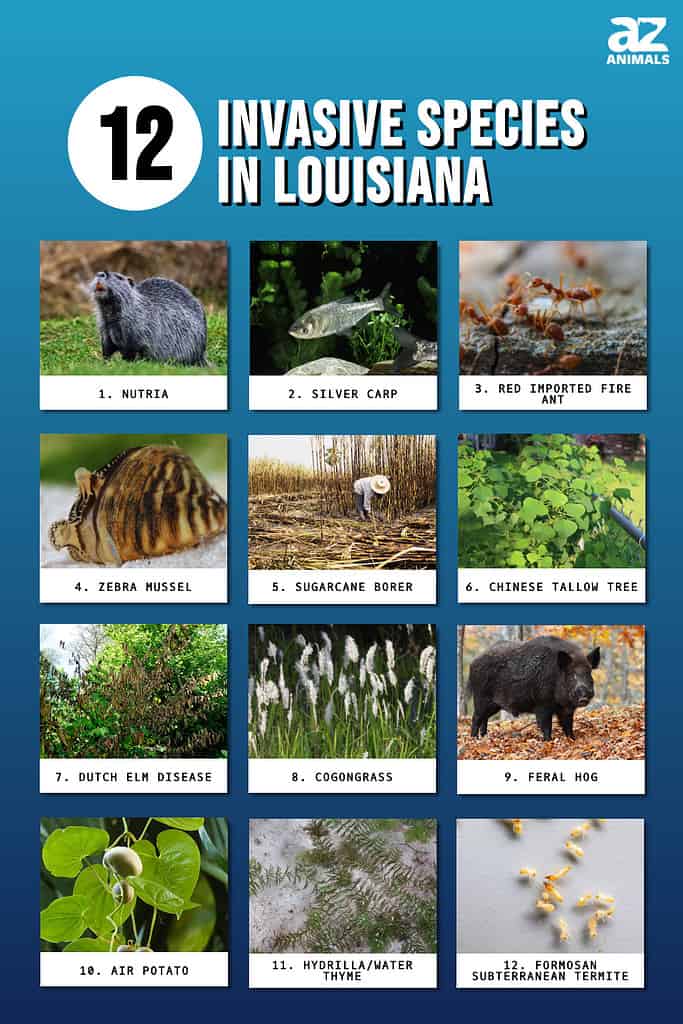
1. Nutria (Myocastor coypus)
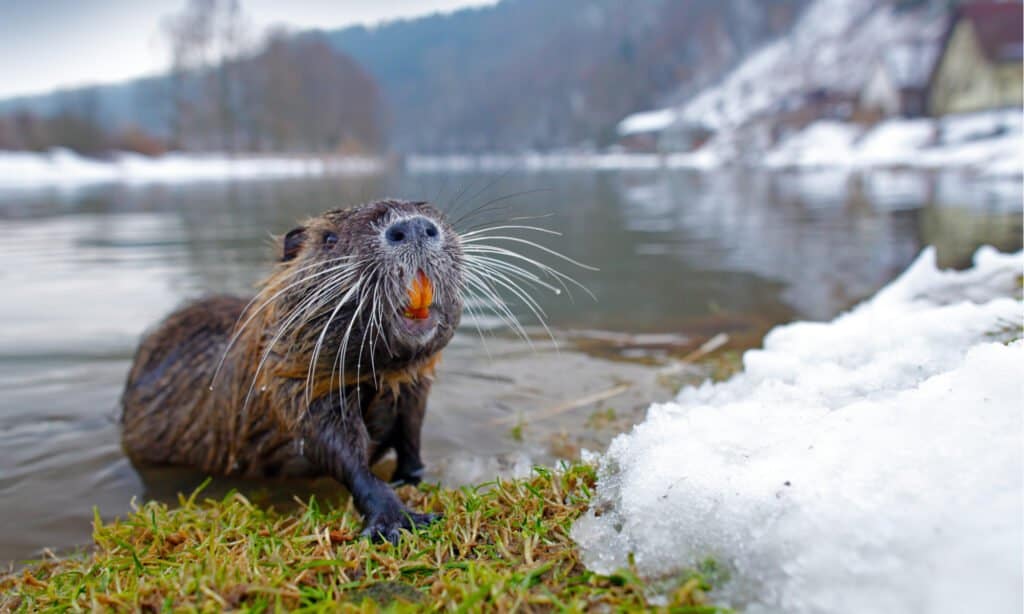
Nutria superficially resembles beavers and capybaras. Their long, orange teeth get their color from their iron-rich enamel coating.
©Ondrej Prosicky/Shutterstock.com
The unusual-looking nutria is perhaps Louisiana’s most well-known and easily recognizable invasive animal thanks to its large size, widespread range, and unique appearance. Even though it’s native to South America, fur traders brought this massive rodent to the United States in the 1930s. Soon after, the nutria quickly became part of the state’s lucrative trapping industry. At the same time, though, it quickly became apparent that Louisiana’s hot, humid climate was ideal for the species to thrive and reproduce with little interference from other animals.
Also known as a coypu, this large, heavy-bodied rodent somewhat resembles a capybara or beaver at a glance. Although it is entirely herbivorous, its tendency to dig large burrows and eat up to 25% of its body weight in vegetation daily is incredibly destructive to Louisiana’s crops. Even more problematic is its propensity for spreading diseases to various species by contaminating commercial and residential water supplies with its waste.
Averaging 16 to 24 inches long and a hefty 10 to 20 pounds, the typical nutria is short and rotund with long, beaver-like orange teeth. Its body is covered in three protective layers of thick, water-resistant, dark brown fur. Although they can live for up to six years, most wild individuals rarely live more than two years.
2. Silver Carp (Hypophthalmichthys molitrix)
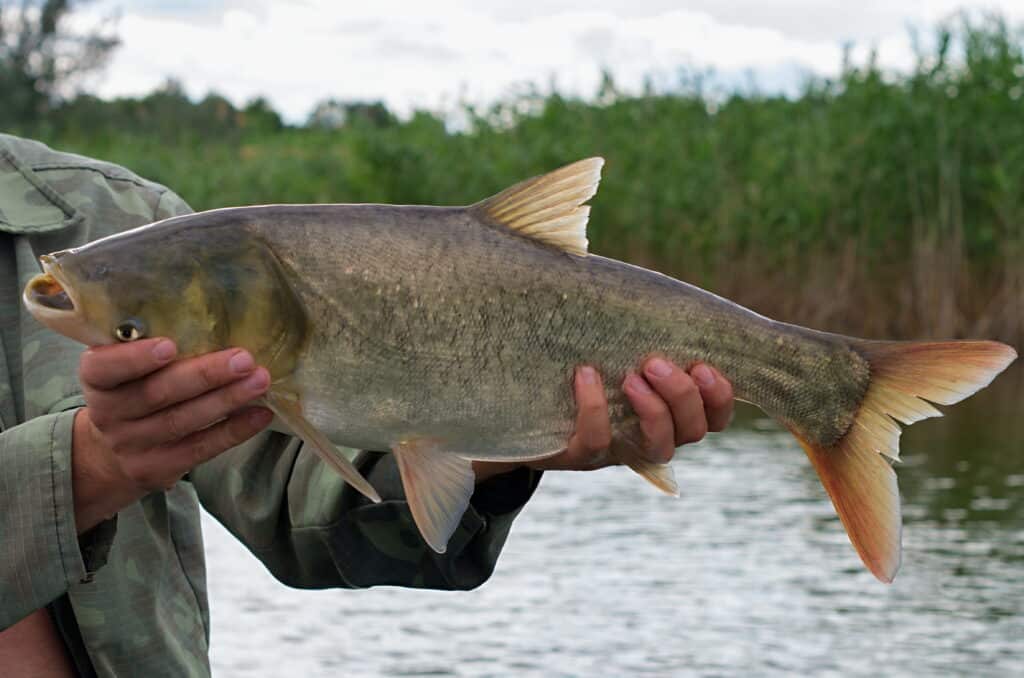
Silver carp mainly eat phytoplankton, which is an essential food source for native larval fish and mussel species.
©Balakleypb/Shutterstock.com
The silver carp is one of around 10 species of Asian carp that has been introduced to an area outside of its actual native range. The species was originally part of an aquaculture program in the 1970s that was intended to improve water quality in ponds and sewage lagoons by controlling algae growth. However, after a series of floods, large numbers of the fish were able to escape captivity and disperse throughout the Mississippi River.
Over time, the species was able to reproduce and establish sizable wild populations. The main reason why they are so destructive is their diet, which consists mainly of algae. The algae these carp eat is also crucial to the growth of native larval fish and mussel species. Thanks to its massive size, speed, and strength, the silver carp can vastly outcompete these native species with ease.
True to its name, the silver carp’s body is primarily silver in color. It can weigh anywhere from 5 to 110 pounds when fully grown and reach 24 to 40 inches long. Despite their impressive size, though, they are unpalatable and often outright toxic to most animals. This is due to the large amounts of algal toxins in their bodies from their algae-rich diet. Bizarrely, they are filter feeders that completely lack stomachs. They essentially constantly filter feed on phytoplankton passively while swimming.
3. Red Imported Fire Ant (Solenopsis invicta)

Red imported fire ants form massive nests that can have multiple queens and up to 300,000 workers.
©NOTE OMG/Shutterstock.com
Also originally native to South America, the red imported fire ant is an invasive species with a nasty bite and enormous ecological impact despite its small size. It has been unintentionally introduced to a wide range of areas far outside its native range, including many US states, Australia, parts of Asia, and New Zealand. Millions of people in the United States experience its painful, venomous sting each year, with many developing allergies to the venom.
Incredibly, red imported fire ants also cause billions of dollars every year in damage to both urban and rural areas worldwide. They were likely originally introduced to the US in the 1930s through the Port of Mobile, Alabama. Their massive nests can have hundreds of thousands of individual ants and multiple queens, which makes them a challenge to eradicate. They particularly thrive in Louisiana due to its hot, humid climate and soft soil, which is ideal for nest building.
In general, the typical red imported fire ant is just ⅛” to ¼” long when fully mature. They have reddish-brown bodies, prominent stingers, and large eyes. Compared to other ant species, they are also incredibly fast-moving and aggressive. In addition to displacing many native ant species, they are extremely dangerous to small and juvenile animals due to their swarming behavior and ability to sting their victims multiple times in rapid succession.
4. Zebra Mussel (Dreissena polymorpha)

Zebra mussels get their name from the brown and off-white stripes on their shells.
©iStock.com/VitalisG
The zebra mussel is a small, freshwater bivalve mollusk originally native to Russia and Ukraine’s Caspian Sea. Like all invasive species, though, they have been introduced to many areas far outside of their native range, including the United States, various eastern and western European countries, and even as far north as Canada. Even though they’re very small at just one to two inches long, they are capable of displacing native fish species and doing substantial damage.
Zebra mussels get their common name from the uniquely brown and off-white striped pattern on their shells. However, this striping is not always present, and exact markings can vary from individual to individual. During their four-to-six-year lifespans, they often kill much larger mussel species by attaching to them. They also increase water clarity, which results in increased growth of various aquatic plant species. This, in turn, affects water quality due to the increased number of said aquatic plants dying and washing up on shorelines.
Another reason why zebra mussels are so troublesome is their exceptionally hardy nature. They can tolerate a wide range of environmental conditions, temperatures, and habitats. They can easily attach themselves to just about any surface or substrate, and females lay millions of eggs per year. As a fast-growing species, they can begin reproducing just one year into their life cycle.
5. Sugarcane Borer (Diatraea saccharalis)

Sugarcane borer larvae can be extremely damaging to sugarcane crops.
©satit_srihin/Shutterstock.com
One of Louisiana’s most destructive invasive insects is the sugarcane borer, a type of moth from the grass moth family. The species is native to Central America and the Caribbean region, as well as parts of South America. However, it was introduced to Louisiana in the 1850s via sugarcane imports from Hispaniola. Since then, it has spread to several surrounding states along the Gulf Coast, primarily Alabama, Texas, and Mississippi.
The sugarcane borer, as its name implies, is a tremendously destructive pest, particularly in its larval form. During this life stage, it feeds on large amounts of staple crops like sugarcane, corn, rice, and sorghum. By burrowing into the stalks of sugarcane, it eats away at it from the inside. This greatly weakens and can even kill the stalks as a result, drastically cutting into crop yields in turn.
The average sugarcane borer larva is just ¾” to 1” in length. In its mature moth form, its wingspan averages just over an inch wide. Its body is mostly pale, pinkish, or silvery beige with darker flecks of brown along its body and wings. Females are slightly larger than males overall.
6. Chinese Tallow Tree (Triadica sebifera)
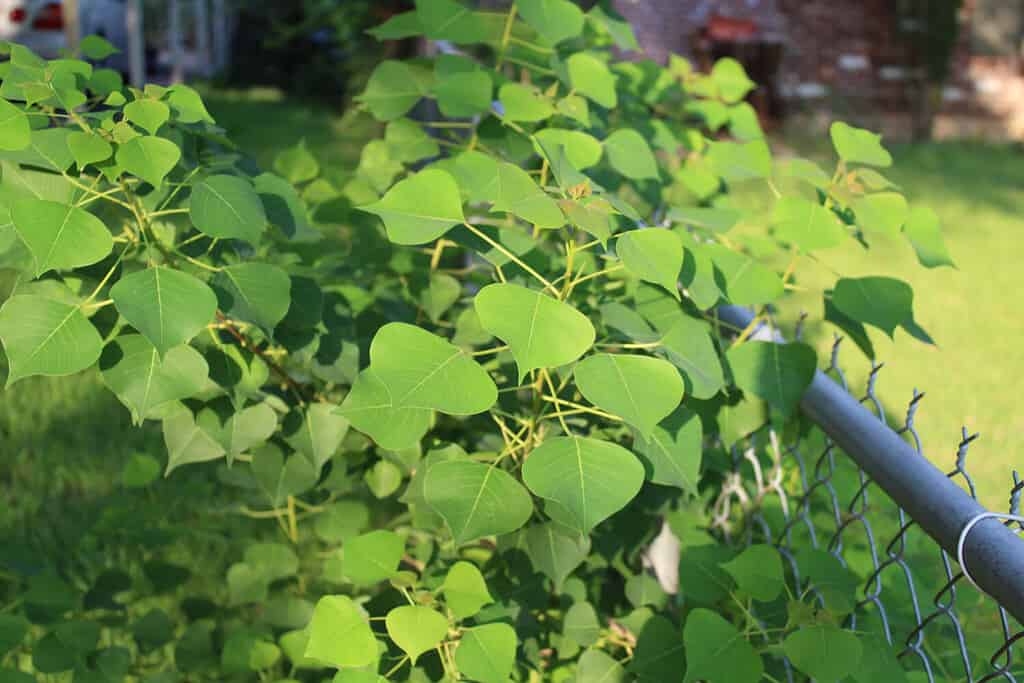
Chinese tallow trees are exceptionally hardy, reproduce quickly, and have no natural predators.
©Wirestock Creators/Shutterstock.com
The next invasive species in Louisiana we’ll be looking at is the Chinese tallow tree, an incredibly useful plant–within its native range, anyway. Native to eastern China, as its name suggests, the tree has many common names depending on where you live: the Florida aspen, the chicken tree, and the gray popcorn tree, among many others. Its seeds are coated in a fatty, oily substance used for the production of various products, primarily candles, and soaps.
Outside of its native range, though, the Chinese tallow tree is a danger to North American ecosystems. Thanks to its hardy nature, it can easily outcompete native tree and plant species, threatening them with extinction. In Houston, Texas, for example, the Chinese tallow represents almost a quarter of all trees, despite being the only invasive tree species in the area. Even more problematic is its rapid reproduction rate and poisonous leaves and berries. This means it has no natural predators willing to eat it and it can spread extremely quickly.
Interestingly, the Chinese tallow was brought to the United States back in the 1770s–by none other than founding father Benjamin Franklin. Historians believe he brought it to the States intending for it to be used as a source of oil for soap making, as well as ornamental purposes. The tree is easy to recognize by its greenish-yellow flowers and small, round seeds coated in a white, waxy material.
7. Dutch Elm Disease (Ophiostoma ulmi)

Dutch elm disease causes elm leaves to turn yellow and brown before eventually wilting entirely.
©AJSTUDIO PHOTOGRAPHY/Shutterstock.com
Let’s take a brief detour to examine the only invasive fungus on this list: the ominously-named Dutch elm disease. Considering researchers estimate it’s responsible for the deaths of over 100 million elm trees, this name is quite fitting. The fungus originated in Europe in the early 1900s. Since then, it has spread to North America, where furniture makers unintentionally introduced it in the 1920s by using imported European elm logs to craft their wares.
In more recent years, several newer, more destructive forms of Dutch elm disease have emerged, further contributing to its spread. Critically, these newer variants are also more difficult to kill and more aggressive than their original iteration.
Though it generally prefers warm, humid, subtropical climates, it is hardy and able to tolerate cooler, drier environments. Its spread is greatly facilitated by the help of the elm bark beetle. By burrowing into the trees, the beetles damage and weaken the trees, in turn providing ideal conditions for the fungus to spread further.
Elm trees infected with the fungus will typically have yellow, wilted leaves and thin, dark streaks throughout the wood. This invasive species thrives in Louisiana where the climate is humid and warm and the soil is moist. However, it also has spread to more temperate, drier climates as far north as Canada.
8. Cogongrass (Imperata cylindrica)
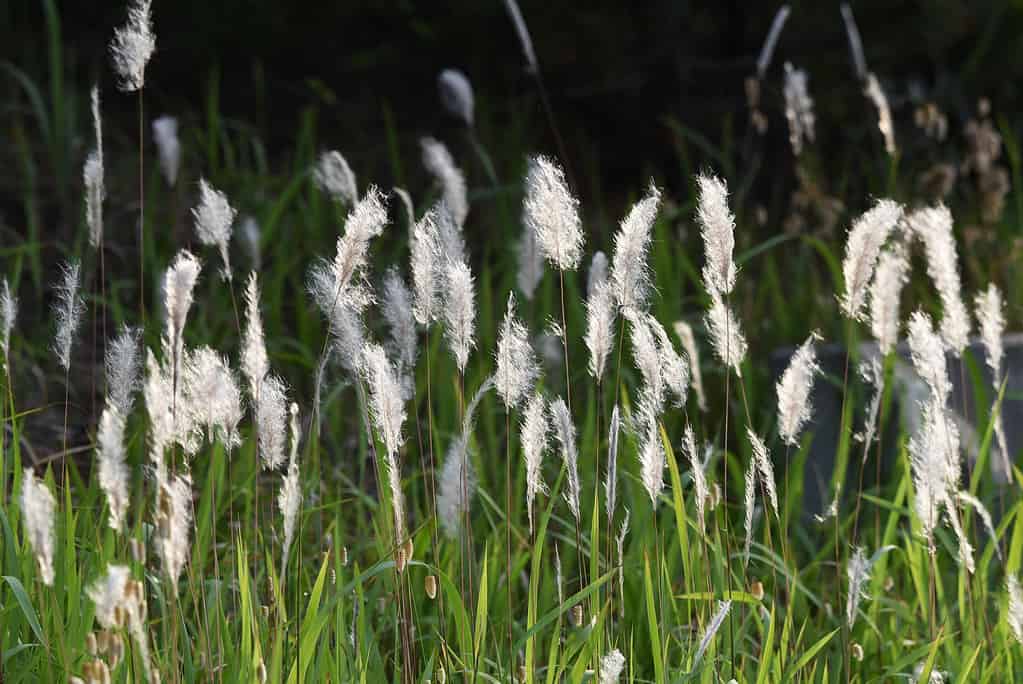
Cogongrass has thin, almost feathery tips that look soft, but don’t be fooled–they’re razor-sharp.
©tamu1500/Shutterstock.com
Up next on Louisiana’s most wanted invasive species is cogongrass. It’s also known as kunai grass within its native habitat, Japan, where it gets this common name from its sharp, blade-like tips and superficially similar appearance to the kunai throwing knife used by samurai. Interestingly, similar to the red imported fire ant discussed earlier, cogongrass also entered the United States via the Port of Mobile, Alabama in the early 1900s.
As one of the world’s top 10 most destructive weeds according to the Global Invasive Species Database, cogongrass is problematic as an invasive species in Louisiana and elsewhere for several key reasons. For starters, it is exceptionally hardy and reproduces very quickly. It’s also able to easily outcompete native plant species. At the same time, though, it’s extremely flammable, widespread, and dense, meaning it contributes directly to the spread of wildfires.
But cogongrass isn’t just flammable, fast-growing, and hardy–it’s also unpalatable to most livestock and other animals in general. It has virtually no nutritional value, and its sharp blades are painful for most animals to consume. Fortunately, the Louisiana Department of Agriculture and Forestry implemented a Cogongrass Treatment Program in 2018, which aims to control the invasive plant population in the state.
9. Feral Hog (Sus domesticus/Sus scrofa)
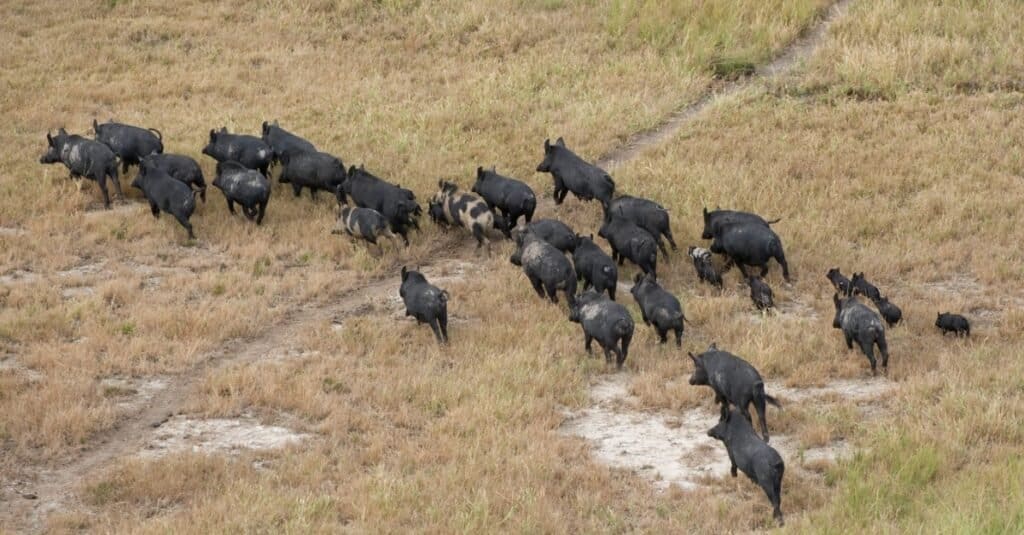
Feral pigs cause billions of dollars in agricultural and property damage every year in the United States.
©iStock.com/JohnCarnemolla
Next, we’ll circle back to invasive animals in Louisiana with one of the state’s larger, more aggressive species: the feral hog. There are around six million feral pigs currently roaming the United States. Every year, they’re estimated to cause billions of dollars in agricultural and property damage. Louisiana alone has a population of around 700,000 feral pigs that cause over $75 million in damages yearly.
Much of this damage is caused by feral hogs rooting around in fields and eating nearly anything they dig up, from plants and insects to rodents, birds, small reptiles, and even larger mammals like deer fawns. In addition to being destructive, feral pigs are also fast and aggressive and often attack humans when approached. Furthermore, they are key spreaders of numerous harmful pathogens that cause illnesses like salmonella, swine flu, toxoplasmosis, and leptospirosis.
Several measures have been taken by Louisiana’s government to control the state’s feral hog population. These include recreational hunting and trapping, which requires a Louisiana Basic Hunting License. They’re also commonly shot down via helicopter and by private homes and landowners. However, because these invasive animals are so hardy and reproduce so quickly, researchers estimate at least three-quarters of the state’s feral hogs need to be eradicated to adequately control the population.
10. Air Potato (Dioscorea bulbifera)

Air potatoes have very large, wide leaves that tend to cover and shade out native plants growing underneath and alongside them.
©Jillian Cain Photography/Shutterstock.com
The air potato goes by many common names, including the air yam, potato yam, and parsnip yam. Originally native to parts of Africa, Asia, and northern Australia, this species of true yam is an invasive, noxious weed in many US states, most notably Louisiana and Florida. It grows quickly and can cover a lot of ground thanks to its far-reaching vines and large, wide leaves. Even if the plant is cut down to the ground, the tubers below the surface can remain and simply release new vines later.
What makes the invasive air potato even more troublesome is its much-debated toxicity. While cultivated forms within their native range are generally safe to eat, uncultivated varieties like those in Louisiana can be poisonous to humans and many other animal species.
Fortunately, Louisiana has the perfect weapon against the air potato’s spread: the air potato leaf beetle. This insect is native to Asia, but the Bayou State’s government has utilized captive-grown individuals to control the growth of air potatoes. By chewing holes in the air potatoes’ leaves and, crucially, only air potato leaves, these helpful, host-specific little beetles have greatly reduced the invasive plant’s potential for damage.
11. Hydrilla/Water Thyme (Hydrilla verticillata)
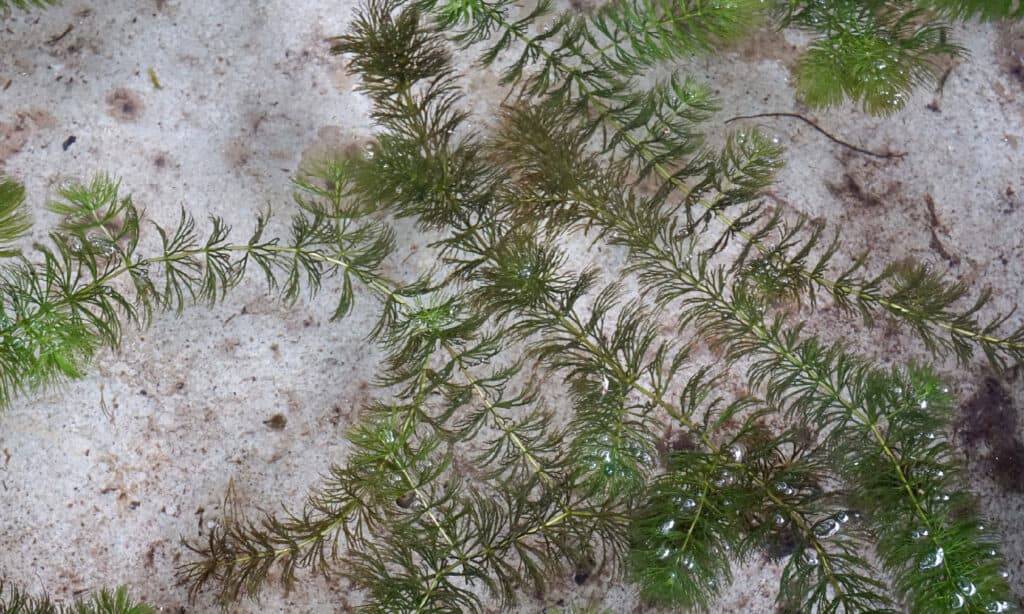
©iStock.com/mansum008
The last invasive plant in Louisiana we’ll be looking at here is the water thyme plant, also known as hydrilla. Native to Asia, hydrilla was introduced to the United States in the 1950s primarily for use in aquariums. Unfortunately, it made its way into Miami, Florida’s waterways, and it quickly spread throughout the state. By the 1970s, it was also present in southern Louisiana’s Atchafalaya River Basin.
This aquatic plant is aggressive and able to easily out-compete other native plant species. Outcompeting native plants creates a monoculture in which an entire area is dominated by hydrilla alone. This, in turn, disturbs entire ecosystems, with the plant being most concentrated and abundant in areas near boat docks and marinas.
Hydrilla is easily recognizable by its small, serrated, dark green leaves. The leaves are typically arranged in a spiral-like pattern in groups of two to eight around the plant’s stem. It also produces tiny, whitish flowers with red streaks.
12. Formosan Subterranean Termite (Coptotermes formosanus)
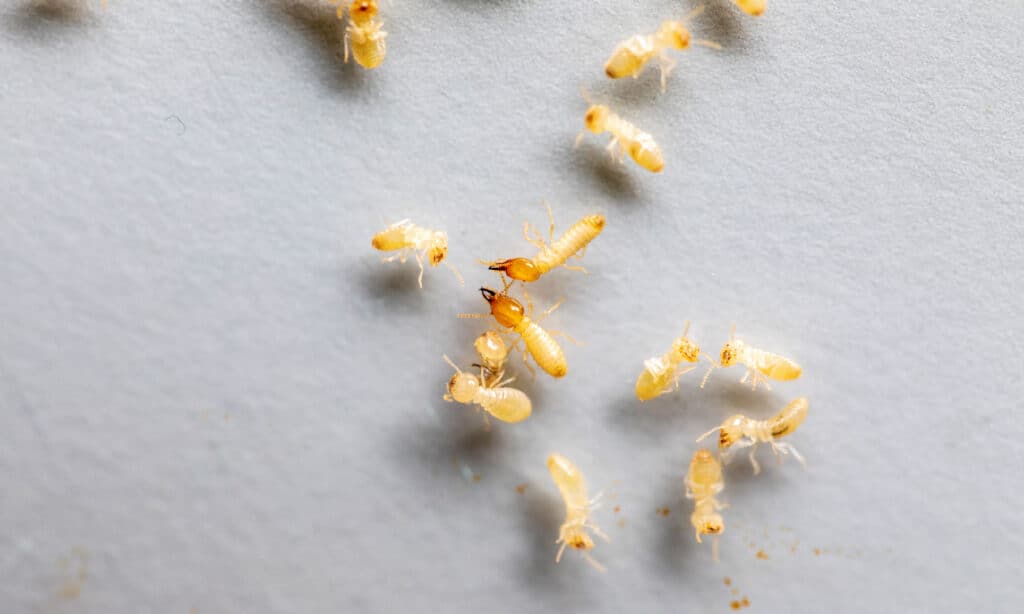
A mature Formosan
termite colony can eat
nearly a pound of wood per day.
©iStock.com/Sinhyu
Finally, we close out this list with the Formosan subterranean termite. This small yet catastrophically destructive insect forms very large colonies that can consume massive amounts of wood very quickly. It’s native to southern China, but it has spread far beyond its native range. It is now invasive in 11 US states, and it was likely introduced to the United States in the 1950s via the Port of New Orleans.
Often referred to as the “super-termite” due to its ability to make quick work of trees and wood structures, the Formosan termite is fortunately not directly aggressive towards humans. However, they can destroy entire buildings like wood sheds in as little as six months, and colonies of them cause around half a billion dollars in damages in Louisiana every year.
In more recent years, the use of stone particle barriers has been somewhat effective at controlling the spread of Formosan termites. Various prevention methods, like insecticides, regular termite inspections, and repairing cracks in buildings’ foundations, have also been helpful. However, the species remains one of Louisiana’s most damaging invasive animals.
Summary of 12 Invasive Species in Louisiana
| Louisiana’s Most Invasive Animals | Scientific Name |
|---|---|
| Nutria (Mammal, rodent), AKA coypu | Myocastor coypus |
| Feral hog (Mammal, ungulate) | Sus domesticus, Sus strofa |
| Silver Carp (Fish, carp/minnow family) | Hypophthalmichthys molitrix |
| Red Imported Fire Ant (Insect, ant family) | Solenopsis invicta |
| Sugarcane Borer (Insect, grass moth family) | Diatraea saccharalis |
| Formosan Subterranean Termite (Insect, termite family) | Coptotermes formosanus |
| Zebra mussel (Mollusk, freshwater mussel family) | Dreisenna polymorpha |
| Louisiana’s Most Invasive Plants and Fungi | Scientific Name |
|---|---|
| Chinese Tallow Tree (Plant), AKA Chicken Tree, Gray Popcorn Tree | Triadica sebifera |
| Hydrilla (Plant), AKA Water thyme | Hydrilla verticillata |
| Cogongrass (Plant), AKA Kunai grass | Imperata cylindrica |
| Air Potato (Plant), AKA Air yam, bitter yam, parsnip yam | Dioscorea bulbifera |
| Dutch Elm Disease (Fungus) | Ophiostoma ulmi |
The photo featured at the top of this post is © Ondrej Prosicky/Shutterstock.com
Thank you for reading! Have some feedback for us? Contact the AZ Animals editorial team.






